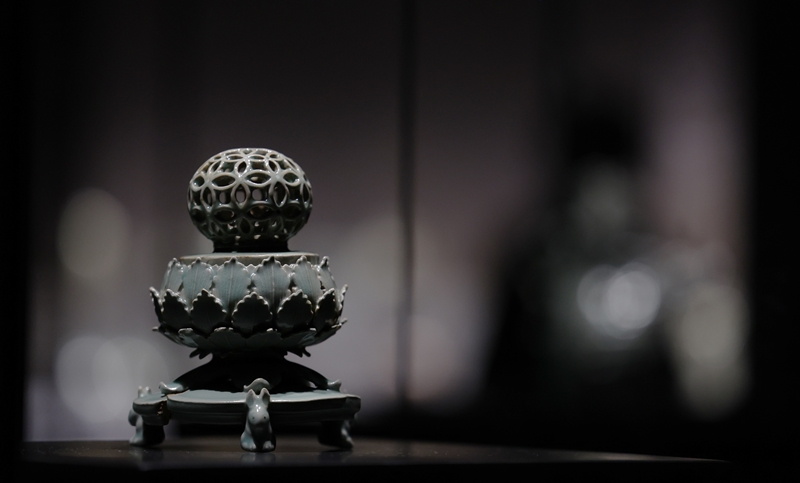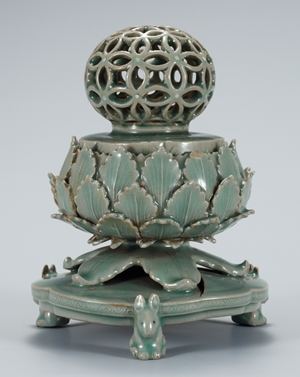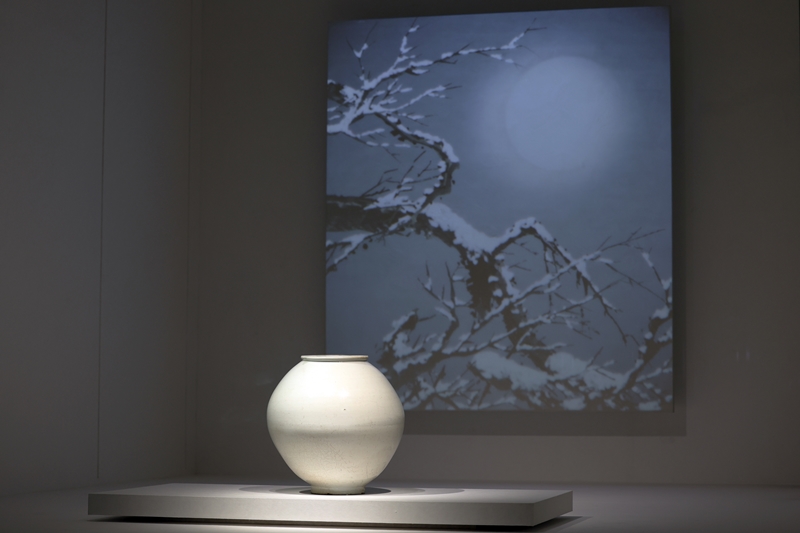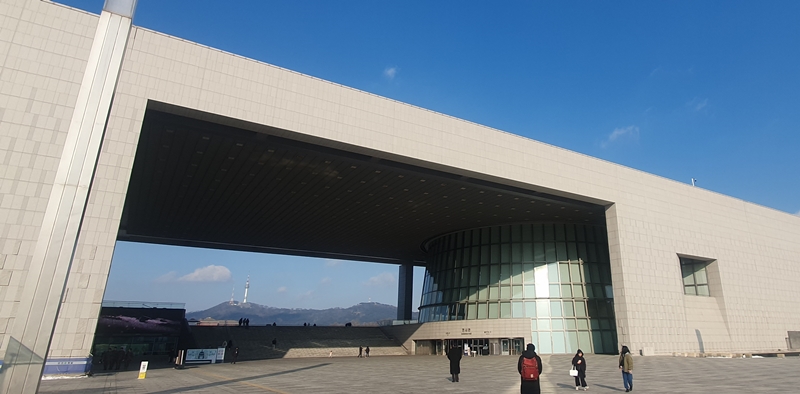
Celadon Incense Burner with Openwork was designated a National Treasure in 1962 as an artwork representing fanciness and elegance. (Lee Jun Young)
By Lee Kyoung Mi

Celadon Incense Burner with Openwork is small at 15.3 cm tall and a diameter of 11.5 cm, but remains a leading work illustrating the outstanding handicraft culture of the Goryeo Dynasty. (National Museum of Korea)
The space Goryeo Celadon Color at the Celadon Gallery is on the third floor of the National Museum of Korea. Among ceramics that emit the color blue at the darkly lit exhibition hall is a sparkling one in the middle: Celadon Incense Burner with Openwork from the Goryeo Dynasty (918-1392).
The three main parts are the lid, which emits the fragrance; the body, where the incense is burned; and the base, which supports it. The lid sports an openwork cloisonne pattern (a carving technique that completely pierces or cuts out the material) and the body's shape is that of a lotus flower with petals attached one by one.
The highlight of the work is the three rabbits at the bottom carrying the burner on their backs, showing them crouching down with their ears pricked up delicately shown. Even the pupils in their eyes were painted with a black iron pigment to make them lifelike.
Several techniques went into making the burner such as engraving, embossing, openwork, inlay and iron painting.
"The incense burner epitomized all the techniques available to a Goryeo celadon artisan," said Seo Yuri, an art curator at the museum. "And here, the distinctive color of Goryeo celadon, or in other words its unique bright and transparent blue glaze, creates beauty."
In his poem "Cheongjabu," poet-novelist Park Jong-hwa (1901-81) called Goryeo celadon "a piece of an autumn sky through which fall rain showers pierced a hole." Art historian Ko Yu-seop (1905-44) described celadon as "the blue flower of the Goryeo people."
Thus a visit to the nation's leading and oldest museum is simply incomplete without seeing the beauty of Goryeo celadon reminiscent of a Korean sky.

The height and diameter of White Porcelain Moon Jar is about 40 cm. Queen Elizabeth II of the U.K. called it the world's most beautiful porcelain and the British auction company Christie's on March 1, 2023, in the written piece "A mysterious and delicate beauty: Korean moon jars" said, "The object conveys the history of a uniquely Korean identity through its masterful simplicity." (Lee Jun Young)
The Buncheong Ware and White Porcelain Gallery on the museum's third floor has a small space displaying White Porcelain Moon Jar. Two chairs opposite the work with a video of falling snow in the background allow visitors to observe the porcelain for a while.
Believed to have been made between the late 17th to the early 18th century, the big and round jar resembles a full moon and was called wonho (round jar) during Japanese colonial rule of the Korean Peninsula (1910-45). It was renamed "moon jar" by art historian Ko, a pioneer of Korean art, and artist Kim Whanki (1913-74).
A jar of this size is difficult to make in one attempt, so it has a trace in the middle of joining the semicircular body with the top and bottom. Though round, its shape is slightly asymmetrical between left and right for an uneven appearance, but this gives it a natural beauty like the moon. The work lacks delicate or fancy designs and its gentle white and elegant flowing curves are said to soothe the mind.
"White Porcelain Moon Jar was made 300 years ago but has a contemporary sense," another art curator of the museum Im Jin A said. "Its white background gives a bright and warm feeling and its unartificial and natural shape makes it closer to an object rather than a functional jar."
The gallery exit features a tactile corner where visitors can touch the jar's surface and feel its sleek and soft texture.

This is an exterior view of the National Museum of Korea in Seoul's Yongsan-gu District. (Lee Kyoung Mi)
# Enjoying National Museum of Korea (II)
- Trying to see everything at the massive museum could prove physically exhausting. So taking it slow and going on occasional breaks throughout the museum on soft couches and benches and at cafes are recommended.
- The National Museum of Korea is a great place for photo opps. On a sunny day, take snaps of the blue sky and white clouds and N (Namsan) Seoul Tower in the distance, both of which are visible between the museum's buildings. Taking photos before entering and after leaving the museum is highly recommended, as even novices can take great shots.
km137426@korea.kr
![[Must-sees at Korean museums] ④ Buyeo Nat'l Museum](/upload/content/image/49249826d45a4c1e9e5f2dbd370962cb_20240418151235.png)
![[Must-sees at Korean museums] ③ Gwangju Nat'l Museum](/upload/content/image/a930dfb35b144d6abdfb4483adcc7bf4_20240314090859.jpg)
![[Must-sees at Korean museums] ② Gyeongju Nat'l Museum](/upload/content/image/9a4d39e2842348aca36c10d73fb90f0a_20240216114311.jpg)
![[Must-sees at Korean museums] ① National Museum of Korea (II)](/upload/content/image/1c4dec52513347a98b9c43c9fd62551e_20240118131624.jpg)
![[Must-sees at Korean museums] ① National Museum of Korea (I)](/upload/content/image/a39a36cb636e4c02aae1ab053f63fe57_20240112112911.jpg)